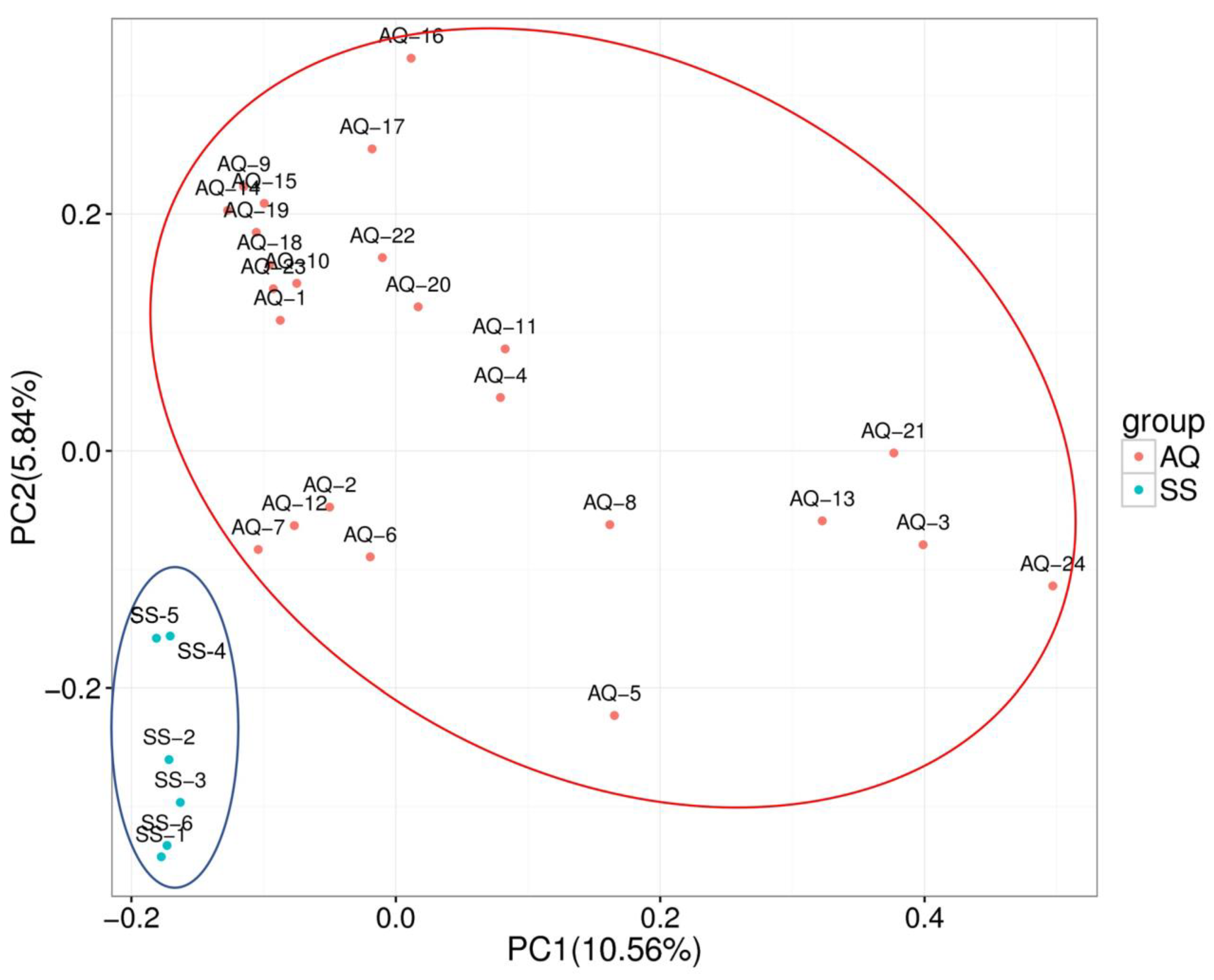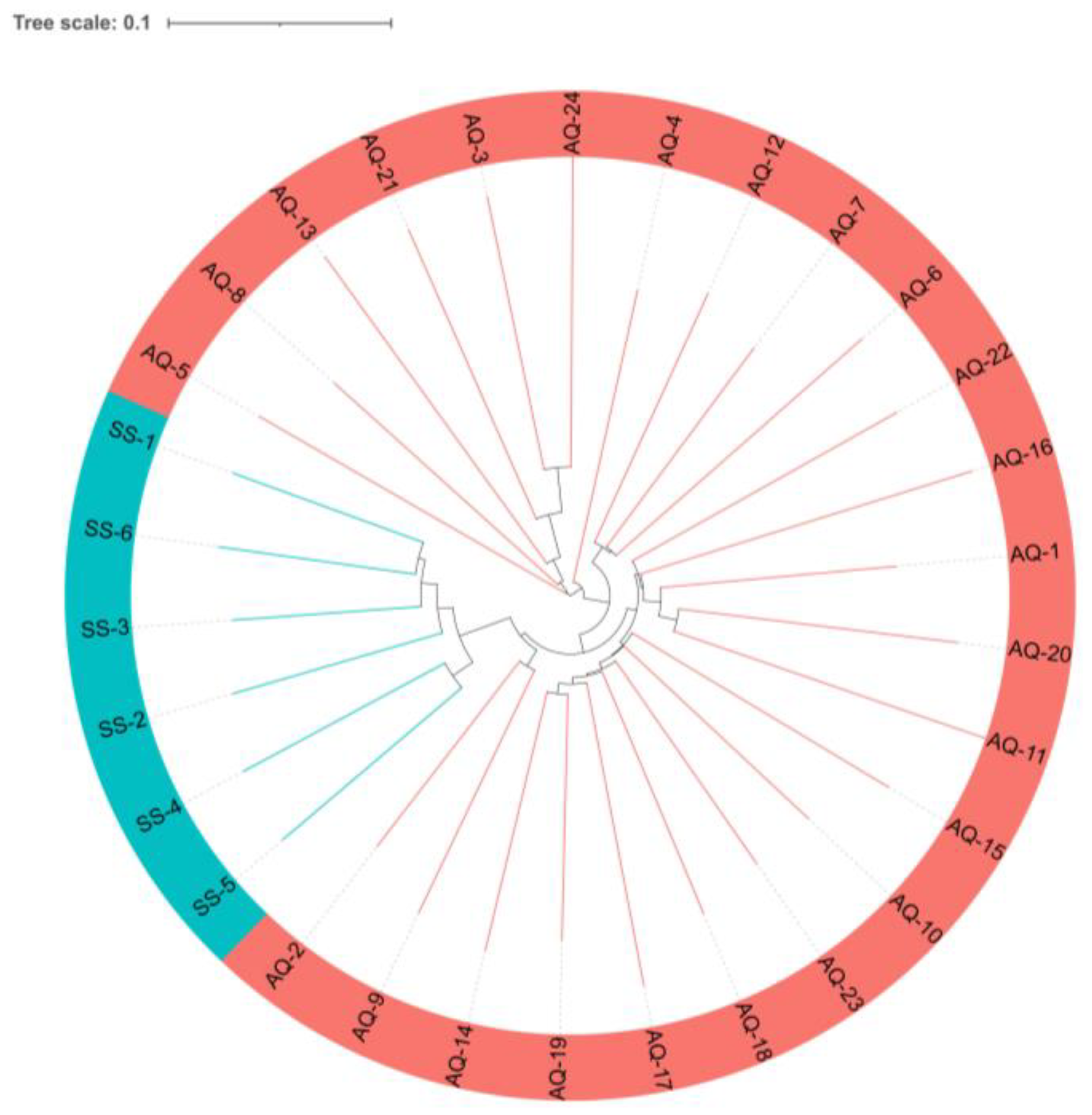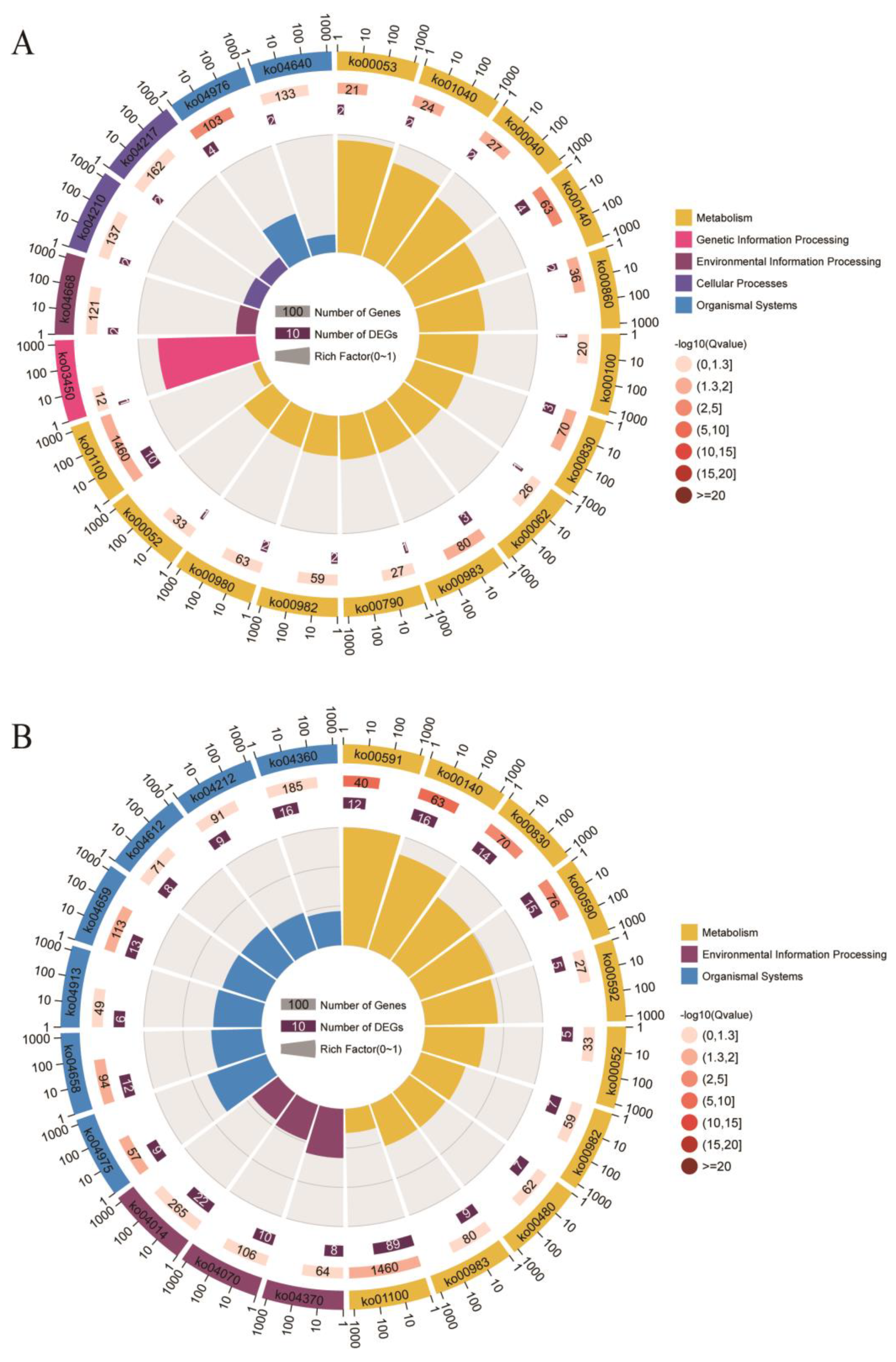Copy Number Variation Analysis Revealed the Evolutionary Difference between Chinese Indigenous Pigs and Asian Wild Boars
Abstract
1. Introduction
2. Materials and Methods
2.1. Sequencing Data Reference
2.2. CNV and CNVR Detection
2.3. CNVR Selection
2.4. Functional Annotation of CNVRs
3. Results
3.1. CNV and CNVR Detection
3.2. PCA and Evolutionary Tree Analysis
3.3. Differential CNVRs Measurement
3.4. Functional Analysis
3.5. QTLs Overlapping with Identified CNVRs
4. Discussion
5. Conclusions
Supplementary Materials
Author Contributions
Funding
Institutional Review Board Statement
Informed Consent Statement
Data Availability Statement
Acknowledgments
Conflicts of Interest
References
- Sales, J.; Kotrba, R. Meat from wild boar (Sus scrofa L.): A review. Meat Sci. 2013, 94, 187–201. [Google Scholar] [CrossRef] [PubMed]
- Lye, Z.N.; Purugganan, M.D. Copy Number Variation in Domestication. Trends Plant Sci. 2019, 24, 352–365. [Google Scholar] [CrossRef] [PubMed]
- Xie, C.; Tammi, M.T. CNV-seq, a new method to detect copy number variation using high-throughput sequencing. BMC Bioinform. 2009, 10, 80. [Google Scholar] [CrossRef]
- Alkan, C.; Coe, B.P.; Eichler, E.E. Genome structural variation discovery and genotyping. Nat. Rev. Genet. 2011, 12, 363–376. [Google Scholar] [CrossRef]
- Paudel, Y.; Madsen, O.; Megens, H.-J.; Frantz, L.A.F.; Bosse, M.; Bastiaansen, J.W.M.; Crooijmans, R.P.M.A.; Groenen, M.A.M. Evolutionary dynamics of copy number variation in pig genomes in the context of adaptation and domestication. BMC Genom. 2013, 14, 449. [Google Scholar] [CrossRef] [PubMed]
- Stankiewicz, P.; Lupski, J.R. Structural variation in the human genome and its role in disease. Annu. Rev. Med. 2010, 61, 437–455. [Google Scholar] [CrossRef]
- Stranger, B.E.; Forrest, M.S.; Dunning, M.; Ingle, C.E.; Beazley, C.; Thorne, N.; Redon, R.; Bird, C.P.; de Grassi, A.; Lee, C.; et al. Relative impact of nucleotide and copy number variation on gene expression phenotypes. Science 2007, 315, 848–853. [Google Scholar] [CrossRef]
- Fang, H.; Sheng, S.; Chen, B.; Wang, J.; Mao, D.; Han, Y.; Liu, Y.; Wang, X.; Gui, S.; Zhang, T.; et al. A Pan-Cancer Analysis of the Oncogenic Role of Cell Division Cycle-Associated Protein 4 (CDCA4) in Human Tumors. Front. Immunol. 2022, 13, 826337. [Google Scholar] [CrossRef]
- Zheng, X.; Zhao, P.; Yang, K.; Ning, C.; Wang, H.; Zhou, L.; Liu, J. CNV analysis of Meishan pig by next-generation sequencing and effects of AHR gene CNV on pig reproductive traits. J. Anim. Sci. Biotechnol. 2020, 11, 42. [Google Scholar] [CrossRef]
- Yuan, C.; Lu, Z.; Guo, T.; Yue, Y.; Wang, X.; Wang, T.; Zhang, Y.; Hou, F.; Niu, C.; Sun, X.; et al. A global analysis of CNVs in Chinese indigenous fine-wool sheep populations using whole-genome resequencing. BMC Genom. 2021, 22, 78. [Google Scholar] [CrossRef]
- Xu, L.; Hou, Y.; Bickhart, D.M.; Zhou, Y.; Hay, E.H.A.; Song, J.; Sonstegard, T.S.; Van Tassell, C.P.; Liu, G.E. Population-genetic properties of differentiated copy number variations in cattle. Sci. Rep. 2016, 6, 23161. [Google Scholar] [CrossRef]
- Chen, C.; Qiao, R.; Wei, R.; Guo, Y.; Ai, H.; Ma, J.; Ren, J.; Huang, L. A comprehensive survey of copy number variation in 18 diverse pig populations and identification of candidate copy number variable genes associated with complex traits. BMC Genom. 2012, 13, 733. [Google Scholar] [CrossRef]
- Revilla, M.; Puig-Oliveras, A.; Castello, A.; Crespo-Piazuelo, D.; Paludo, E.; Fernandez, A.I.; Ballester, M.; Folch, J.M. A global analysis of CNVs in swine using whole genome sequence data and association analysis with fatty acid composition and growth traits. PLoS ONE 2017, 12, e0177014. [Google Scholar] [CrossRef]
- Wang, Z.; Guo, Y.; Liu, S.; Meng, Q. Genome-Wide Assessment Characteristics of Genes Overlapping Copy Number Variation Regions in Duroc Purebred Population. Front. Genet. 2021, 12, 753748. [Google Scholar] [CrossRef]
- Li, M.; Tian, S.; Jin, L.; Zhou, G.; Li, Y.; Zhang, Y.; Wang, T.; Yeung, C.K.L.; Chen, L.; Ma, J.; et al. Genomic analyses identify distinct patterns of selection in domesticated pigs and Tibetan wild boars. Nat. Genet. 2013, 45, 1431–1438. [Google Scholar] [CrossRef] [PubMed]
- Wu, X.; Zhou, R.; Wang, Y.; Zhang, W.; Zheng, X.; Zhao, G.; Zhang, X.; Yin, Z.; Ding, Y. Genome-wide scan for runs of homozygosity in Asian wild boars and Anqing six-end-white pigs. Anim. Genet. 2022, 53, 867–871. [Google Scholar] [CrossRef] [PubMed]
- Abyzov, A.; Urban, A.E.; Snyder, M.; Gerstein, M. CNVnator: An approach to discover, genotype, and characterize typical and atypical CNVs from family and population genome sequencing. Genome Res. 2011, 21, 974–984. [Google Scholar] [CrossRef]
- Trost, B.; Walker, S.; Wang, Z.; Thiruvahindrapuram, B.; MacDonald, J.R.; Sung, W.W.L.; Pereira, S.L.; Whitney, J.; Chan, A.J.S.; Pellecchia, G.; et al. A Comprehensive Workflow for Read Depth-Based Identification of Copy-Number Variation from Whole-Genome Sequence Data. Amer. J. Hum. Genet. 2018, 102, 142–155. [Google Scholar] [CrossRef] [PubMed]
- Wu, Q.D.; Zhou, Y.D.; Wang, Y.; Zhang, Y.; Shen, Y.; Su, Q.; Gao, G.; Xu, H.; Zhou, X.; Liu, B. Whole-genome sequencing reveals breed-differential CNVs between Tongcheng and Large White pigs. Anim. Genet. 2020, 51, 940–944. [Google Scholar] [CrossRef]
- Redon, R.; Ishikawa, S.; Fitch, K.R.; Feuk, L.; Perry, G.H.; Andrews, T.D.; Fiegler, H.; Shapero, M.H.; Carson, A.R.; Chen, W.; et al. Global variation in copy number in the human genome. Nature 2006, 444, 444–454. [Google Scholar] [CrossRef]
- Bu, D.; Luo, H.; Huo, P.; Wang, Z.; Zhang, S.; He, Z.; Wu, Y.; Zhao, L.; Liu, J.; Guo, J.; et al. KOBAS-i: Intelligent prioritization and exploratory visualization of biological functions for gene enrichment analysis. NAR 2021, 49, W317–W325. [Google Scholar] [CrossRef]
- Jiang, Y.; Li, X.; Liu, J.; Zhang, W.; Zhou, M.; Wang, J.; Liu, L.; Su, S.; Zhao, F.; Chen, H.; et al. Genome-wide detection of genetic structure and runs of homozygosity analysis in Anhui indigenous and Western commercial pig breeds using PorcineSNP80k data. BMC Genom. 2022, 23, 373. [Google Scholar] [CrossRef] [PubMed]
- Wang, Y.; Zhang, W.; Wu, X.; Wu, C.; Qian, L.; Wang, L.; Zhang, X.; Yang, M.; Li, D.; Ding, J.; et al. Transcriptomic comparison of liver tissue between Anqing six-end-white pigs and Yorkshire pigs based on RNA sequencing. Genome 2020, 63, 203–214. [Google Scholar] [CrossRef] [PubMed]
- Lu, J.; Lou, H.; Fu, R.; Lu, D.; Zhang, F.; Wu, Z.; Zhang, X.; Li, C.; Fang, B.; Pu, F.; et al. Assessing genome-wide copy number variation in the Han Chinese population. J. Med. Genet. 2017, 54, 685–692. [Google Scholar] [CrossRef]
- Zarrei, M.; MacDonald, J.R.; Merico, D.; Scherer, S.W. A copy number variation map of the human genome. Nat. Rev. Genet. 2015, 16, 172–183. [Google Scholar] [CrossRef]
- Zhang, F.; Gu, W.; Hurles, M.E.; Lupski, J.R. Copy number variation in human health, disease, and evolution. Annu. Rev. Genom. Hum. Genet. 2009, 10, 451–481. [Google Scholar] [CrossRef] [PubMed]
- Nguyen, D.Q.; Webber, C.; Hehir-Kwa, J.; Pfundt, R.; Veltman, J.; Ponting, C.P. Reduced purifying selection prevails over positive selection in human copy number variant evolution. Genome Res. 2008, 18, 1711–1723. [Google Scholar] [CrossRef]
- Wang, Y.; Tang, Z.; Sun, Y.; Wang, H.; Wang, C.; Yu, S.; Liu, J.; Zhang, Y.; Fan, B.; Li, K.; et al. Analysis of genome-wide copy number variations in Chinese indigenous and western pig breeds by 60 K SNP genotyping arrays. PLoS ONE 2014, 9, e106780. [Google Scholar] [CrossRef]
- Zhang, C.; Zhao, J.; Guo, Y.; Xu, Q.; Liu, M.; Cheng, M.; Chao, X.; Schinckel, A.P.; Zhou, B. Genome-Wide Detection of Copy Number Variations and Evaluation of Candidate Copy Number Polymorphism Genes Associated with Complex Traits of Pigs. Front. Vet. Sci. 2022, 9, 909039. [Google Scholar] [CrossRef]
- Doan, T.N.A.; Bianco-Miotto, T.; Parry, L.; Winter, M. The role of angiotensin II and relaxin in vascular adaptation to pregnancy. Reproduction 2022, 164, R87–R99. [Google Scholar] [CrossRef]
- Bani, D. Relaxin: A pleiotropic hormone. Gen. Pharmacol. 1997, 28, 13–22. [Google Scholar] [CrossRef]
- Feugang, J.M.; Rodriguez-Munoz, J.C.; Willard, S.T.; Bathgate, R.A.; Ryan, P.L. Examination of relaxin and its receptors expression in pig gametes and embryos. Reprod. Biol. Endocrinol. 2011, 9, 10. [Google Scholar] [CrossRef]
- Liu, Z.; Yan, H.; Yang, Y.; Wei, L.; Xia, S.; Xiu, Y. Down-regulation of CIT can inhibit the growth of human bladder cancer cells. Biomed. Pharmacother. 2020, 124, 109830. [Google Scholar] [CrossRef] [PubMed]
- Fujii, W.; Nishimura, T.; Kano, K.; Sugiura, K.; Naito, K. CDK7 and CCNH are components of CDK-activating kinase and are required for meiotic progression of pig oocytes. Biol. Reprod. 2011, 85, 1124–1132. [Google Scholar] [CrossRef] [PubMed]
- Liu, G.E.; Hou, Y.; Zhu, B.; Cardone, M.F.; Jiang, L.; Cellamare, A.; Mitra, A.; Alexander, L.J.; Coutinho, L.L.; Dell’Aquila, M.E.; et al. Analysis of copy number variations among diverse cattle breeds. Genome Res. 2010, 20, 693–703. [Google Scholar] [CrossRef]
- Crespo-Piazuelo, D.; Ramayo-Caldas, Y.; Gonzalez-Rodriguez, O.; Pascual, M.; Quintanilla, R.; Ballester, M. A Co-Association Network Analysis Reveals Putative Regulators for Health-Related Traits in Pigs. Front. Immunol. 2021, 12, 784978. [Google Scholar] [CrossRef]
- Grajchen, E.; Wouters, E.; van de Haterd, B.; Haidar, M.; Hardonnière, K.; Dierckx, T.; Van Broeckhoven, J.; Erens, C.; Hendrix, S.; Kerdine-Römer, S.; et al. CD36-mediated uptake of myelin debris by macrophages and microglia reduces neuroinflammation. J. Neuroinflammation 2020, 17, 224. [Google Scholar] [CrossRef] [PubMed]
- Blériot, C.; Barreby, E.; Dunsmore, G.; Ballaire, R.; Chakarov, S.; Ficht, X.; De Simone, G.; Andreata, F.; Fumagalli, V.; Guo, W.; et al. A subset of Kupffer cells regulates metabolism through the expression of CD36. Immunity 2021, 54, 2101–2116. [Google Scholar] [CrossRef]
- Chen, Y.; Zhang, J.; Cui, W.; Silverstein, R.L. CD36, a signaling receptor and fatty acid transporter that regulates immune cell metabolism and fate. J. Exp. Med. 2022, 219, e20211314. [Google Scholar] [CrossRef]
- Zhou, H.; Yu, B.; Sun, J.; Liu, Z.; Chen, H.; Ge, L.; Chen, D. Short-chain fatty acids can improve lipid and glucose metabolism independently of the pig gut microbiota. J. Anim. Sci. Biotechnol. 2021, 12, 61. [Google Scholar] [CrossRef]
- Bonen, A.; Parolin, M.L.; Steinberg, G.R.; Calles-Escandon, J.; Tandon, N.N.; Glatz, J.F.C.; Luiken, J.J.F.P.; Heigenhauser, G.J.F.; Dyck, D.J. Triacylglycerol accumulation in human obesity and type 2 diabetes is associated with increased rates of skeletal muscle fatty acid transport and increased sarcolemmal FAT/CD36. FASEB J. 2004, 18, 1144–1146. [Google Scholar] [CrossRef] [PubMed]
- Li, S.; Wang, H.; Wang, X.; Wang, Y.; Feng, J. Betaine affects muscle lipid metabolism via regulating the fatty acid uptake and oxidation in finishing pig. J. Anim. Sci. Biotechnol. 2017, 8, 72. [Google Scholar] [CrossRef] [PubMed]
- Zanger, U.M.; Schwab, M. Cytochrome P450 enzymes in drug metabolism: Regulation of gene expression, enzyme activities, and impact of genetic variation. Pharmacol. Ther. 2013, 138, 103–141. [Google Scholar] [CrossRef]
- Coon, M.J.; Ding, X.X.; Pernecky, S.J.; Vaz, A.D. Cytochrome P450: Progress and predictions. FASEB J. 1992, 6, 669–673. [Google Scholar] [CrossRef]
- Paudel, Y.; Madsen, O.; Megens, H.J.; Frantz, L.A.; Bosse, M.; Crooijmans, R.P.; Groenen, M.A. Copy number variation in the speciation of pigs: A possible prominent role for olfactory receptors. BMC Genom. 2015, 16, 330. [Google Scholar] [CrossRef]
- Grindflek, E.; Berget, I.; Moe, M.; Oeth, P.; Lien, S. Transcript profiling of candidate genes in testis of pigs exhibiting large differences in androstenone levels. BMC Genet. 2010, 11, 4. [Google Scholar] [CrossRef]
- Sawant-Basak, A.; Obach, R.S. Emerging Models of Drug Metabolism, Transporters, and Toxicity. Drug Metab. Dispos. 2018, 46, 1556–1561. [Google Scholar] [CrossRef] [PubMed]
- Zakim, D.; Cantor, M.; Eibl, H. Phospholipids and UDP-glucuronosyltransferase. Structure/function relationships. J. Biol. Chem. 1988, 263, 5164–5169. [Google Scholar] [CrossRef]
- Young, J.M.; Endicott, R.M.; Parghi, S.S.; Walker, M.; Kidd, J.M.; Trask, B.J. Extensive copy-number variation of the human olfactory receptor gene family. Amer. J. Hum. Genet. 2008, 83, 228–242. [Google Scholar] [CrossRef] [PubMed]
- Rouquier, S.; Giorgi, D. Olfactory receptor gene repertoires in mammals. Mutat. Res. 2007, 616, 95–102. [Google Scholar] [CrossRef] [PubMed]
- Nguyen, D.T.; Lee, K.; Choi, H.; Choi, M.-K.; Le, M.T.; Song, N.; Kim, J.-H.; Seo, H.G.; Oh, J.-W.; Lee, K.; et al. The complete swine olfactory subgenome: Expansion of the olfactory gene repertoire in the pig genome. BMC Genom. 2012, 13, 584. [Google Scholar] [CrossRef] [PubMed]
- Zhang, Y.; Zhang, J.; Gong, H.; Cui, L.; Zhang, W.; Ma, J.; Chen, C.; Ai, H.; Xiao, S.; Huang, L.; et al. Genetic correlation of fatty acid composition with growth, carcass, fat deposition and meat quality traits based on GWAS data in six pig populations. Meat Sci. 2019, 150, 47–55. [Google Scholar] [CrossRef] [PubMed]
- Zhang, W.; Zhang, J.; Cui, L.; Ma, J.; Chen, C.; Ai, H.; Xie, X.; Li, L.; Xiao, S.; Huang, L.; et al. Genetic architecture of fatty acid composition in the longissimus dorsi muscle revealed by genome-wide association studies on diverse pig populations. Genet. Sel. Evol. 2016, 48, 5. [Google Scholar] [CrossRef]
- Corominas, J.; Marchesi, J.A.P.; Puig-Oliveras, A.; Revilla, M.; Estellé, J.; Alves, E.; Folch, J.M.; Ballester, M. Epigenetic regulation of the ELOVL6 gene is associated with a major QTL effect on fatty acid composition in pigs. Genet. Sel. Evol. 2015, 47, 20. [Google Scholar] [CrossRef] [PubMed]






| Chr | Length | All | AQ | SS | ||||||
|---|---|---|---|---|---|---|---|---|---|---|
| Total | DUP | DEL | Total | DUP | DEL | Total | DUP | DEL | ||
| 1 | 274.33 | 1175 | 641 | 446 | 1157 | 639 | 431 | 457 | 117 | 287 |
| 2 | 151.94 | 1031 | 557 | 369 | 1016 | 556 | 357 | 445 | 147 | 225 |
| 3 | 132.85 | 607 | 316 | 243 | 601 | 315 | 238 | 227 | 47 | 153 |
| 4 | 130.91 | 574 | 276 | 249 | 566 | 276 | 242 | 261 | 78 | 154 |
| 5 | 104.53 | 587 | 292 | 235 | 581 | 292 | 230 | 258 | 70 | 155 |
| 6 | 170.84 | 865 | 475 | 308 | 856 | 473 | 304 | 328 | 93 | 195 |
| 7 | 121.84 | 561 | 274 | 208 | 548 | 272 | 199 | 257 | 66 | 136 |
| 8 | 138.97 | 569 | 226 | 302 | 558 | 222 | 296 | 251 | 47 | 186 |
| 9 | 139.51 | 652 | 320 | 252 | 642 | 320 | 244 | 295 | 81 | 175 |
| 10 | 69.36 | 290 | 109 | 176 | 286 | 108 | 174 | 153 | 31 | 118 |
| 11 | 79.17 | 283 | 74 | 198 | 278 | 74 | 193 | 144 | 18 | 120 |
| 12 | 61.6 | 394 | 210 | 140 | 387 | 209 | 136 | 158 | 42 | 95 |
| 13 | 208.34 | 874 | 445 | 361 | 861 | 445 | 348 | 363 | 102 | 226 |
| 14 | 141.76 | 672 | 351 | 259 | 668 | 350 | 257 | 276 | 84 | 154 |
| 15 | 140.41 | 504 | 262 | 217 | 492 | 261 | 208 | 206 | 56 | 132 |
| 16 | 79.94 | 287 | 81 | 204 | 283 | 81 | 200 | 157 | 22 | 133 |
| 17 | 63.49 | 328 | 132 | 167 | 324 | 132 | 163 | 165 | 38 | 108 |
| 18 | 55.98 | 176 | 70 | 100 | 175 | 70 | 99 | 78 | 8 | 65 |
| Total | 2265.77 | 10,429 | 5111 | 4434 | 10,279 | 5095 | 4319 | 4479 | 1147 | 2817 |
Disclaimer/Publisher’s Note: The statements, opinions and data contained in all publications are solely those of the individual author(s) and contributor(s) and not of MDPI and/or the editor(s). MDPI and/or the editor(s) disclaim responsibility for any injury to people or property resulting from any ideas, methods, instructions or products referred to in the content. |
© 2023 by the authors. Licensee MDPI, Basel, Switzerland. This article is an open access article distributed under the terms and conditions of the Creative Commons Attribution (CC BY) license (https://creativecommons.org/licenses/by/4.0/).
Share and Cite
Fan, S.; Kong, C.; Chen, Y.; Zheng, X.; Zhou, R.; Zhang, X.; Wu, X.; Zhang, W.; Ding, Y.; Yin, Z. Copy Number Variation Analysis Revealed the Evolutionary Difference between Chinese Indigenous Pigs and Asian Wild Boars. Genes 2023, 14, 472. https://doi.org/10.3390/genes14020472
Fan S, Kong C, Chen Y, Zheng X, Zhou R, Zhang X, Wu X, Zhang W, Ding Y, Yin Z. Copy Number Variation Analysis Revealed the Evolutionary Difference between Chinese Indigenous Pigs and Asian Wild Boars. Genes. 2023; 14(2):472. https://doi.org/10.3390/genes14020472
Chicago/Turabian StyleFan, Shuhao, Chengcheng Kong, Yige Chen, Xianrui Zheng, Ren Zhou, Xiaodong Zhang, Xudong Wu, Wei Zhang, Yueyun Ding, and Zongjun Yin. 2023. "Copy Number Variation Analysis Revealed the Evolutionary Difference between Chinese Indigenous Pigs and Asian Wild Boars" Genes 14, no. 2: 472. https://doi.org/10.3390/genes14020472
APA StyleFan, S., Kong, C., Chen, Y., Zheng, X., Zhou, R., Zhang, X., Wu, X., Zhang, W., Ding, Y., & Yin, Z. (2023). Copy Number Variation Analysis Revealed the Evolutionary Difference between Chinese Indigenous Pigs and Asian Wild Boars. Genes, 14(2), 472. https://doi.org/10.3390/genes14020472






